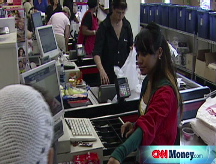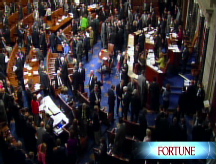Stimulus, take 2: The right way
Experts propose ways to really get the economy back on track for the long haul. Hint: More tax rebates aren't the answer.
NEW YORK (CNNMoney.com) -- It's official. The economy shrunk in the third quarter. In terms of earth-shattering surprises, that should rank up there with the news that Madonna and Guy Ritchie were getting a divorce.
We all knew before today that consumers and businesses have been suffering. And many economists expect that the decline in gross domestic product (GDP) for the fourth quarter will be significantly higher than the 0.3% annualized drop for the third quarter.
So with that in mind, is it time for the government to enact another fiscal stimulus plan to get the economy back on track? Congress held a hearing to discuss that very notion on Thursday morning.
In a word, yes. But this stimulus plan has to be a lot different than merely sending out $1,200 checks to households.
Several economists said that the income tax refunds that many Americans received as part of the $168 billion stimulus package earlier this year didn't do much other than provide a temporary boost to the economy in the second quarter.
With that money largely spent, personal consumption expenditures fell 3.1% in the third quarter, the largest drop since the second quarter of 1980. Apparently, when the Phillies win the World Series, it's bad news for the economy. (Philly Phanatics, don't send me hate mail. I'm just joking! And congrats.)
So Congress needs to do more than just give consumers a short-term fix.
"It is necessary to stimulate the economy. Congress just has to be very careful," said Oscar Gonzalez, an economist with John Hancock Financial Services in Boston. "We need more than just tax cuts that people may use to go out and buy a television. Spending money and getting a quick sugar high is not enough."
Investing in infrastructure: Gonzalez said that the key to a successful stimulus plan is increased spending on infrastructure.
That would provide a bigger lift to the economy since increased spending on construction should lead to more job growth in an industry that sorely needs it in the wake of the housing downturn.
Aid for state governments: Joe Liro, an economist with Stone & McCarthy Research Associates in Princeton, agreed that more money is needed for projects like highway reapir and mass-transit construction. But he added that the federal government also will need to set aside for many cash-strapped state and local governments.
"Washington can run big deficits but many state and local constitutions tend to have requirements for balanced budgets. The federal government will have to bolster local governments," Liro said.
Address housing: Still, Michael Strauss, chief economist with Commonfund, a money management firm based in Wilton, Conn., said that Congress should not forget the average consumer.
"The nuts and bolts of GDP is personal consumption spending. And if you register that on a 1 to 10 with 10 being bad, we were probably at an 8.5," he said.
Strauss also thinks that tax rebates are not the answer though. Instead, he said that anything Washington can do to more directly address plunging home prices and the rise in foreclosures would be good for the overall economy.
"We need something to help out the consumer side of the equation, something in the form of a mortgage refinancing package," he said.
This doesn't mean that a tax rebate is out of the question. But Liro said that rebates should only go to those who need it the most and would be likely to put the cash to use.
"There should be some modest changes to the tax code to put more money in the hands of the bottom rungs on the income ladder. It should be not going to the upper middle class, who would be more likely to save it than spend it," Liro said.
Even though there is a growing belief that more stimulus is needed, the government still needs to be wary of repeating the mistakes from earlier this decade and providing too much of a boost.
After all, the Federal Reserve has already cut interest rates to 1%. The last time the Fed did that, it kept them there for a year. And some economists believe that this prolonged period of easy money set the stage for the housing bubble...which is why we're in this mess in the first place.
In addition, the Fed and Treasury Department have already taken steps to do the same thing with their multi-pronged approach to solving the credit crunch.
That already seems to be helping to bring down bank lending rates and boost the commercial paper market, a key source of short-term funding for businesses.
But it's going to take several months to fully bring the credit markets back to life even though many impatient investors don't want to recognize that fact.
"There appears to be enough liquidity out there. Perhaps we just need a little more time to unclog the arteries in the market," Gonzalez said.
Still, Liro said it's premature to worry about overstimulation given that the economy declined in the third quarter and he expects even steeper drops in the fourth quarter and first two quarters of 2009.
Strauss added that he was confident that current Fed chairman Ben Bernanke has learned from the mistakes of his predecessor Alan Greenspan and that he would quickly move to raise rates again once the economy is showing signs of growth again.
"The party isn't going yet. But when it does, the Fed will take steps to remove the punchbowl," he said.
Finally, the other question about stimulus is perhaps the most important. How much? Liro thinks this second round has to be bigger than the tax rebates.
"You would have to imagine it should be in the $200 billion to $400 billion range. That would be warranted...and I'm a fiscal conservative," he said.
But Gonzalez warned that as serious as the nation's short-term economic problems are, Congress has to spend responsibly.
"Additional stimulus needs to be balanced with other problems. And one issue is the additional increase to the budget deficit and the impact that might have on long-term interest rates," he said. ![]()





